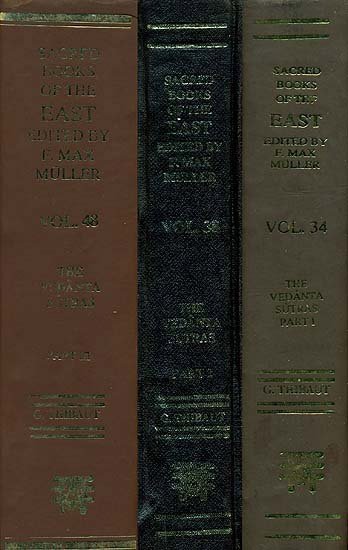Brahma Sutras (Ramanuja)
by George Thibaut | 1904 | 275,953 words | ISBN-10: 8120801350 | ISBN-13: 9788120801356
The English translation of the Brahma Sutras (also, Vedanta Sutras) with commentary by Ramanuja (known as the Sri Bhasya). The Brahmasutra expounds the essential philosophy of the Upanishads which, primarily revolving around the knowledge of Brahman and Atman, represents the foundation of Vedanta. Ramanjua’s interpretation of these sutras from a V...
Sutra 3.3.43
43. On account of the plurality of indicatory marks; for that (proof) is stronger. This also is declared (in the Pūrva Mīmāmsā).
The Taittirīyaka contains another daharavidyā, 'The thousand-headed god, the all-eyed one,' etc. (Mahānār. Up. XI). Here the doubt arises whether this vidyā, as being one with the previously introduced vidyā, states qualities to be included in the meditation enjoined in that vidyā, or qualities to be included in the meditations on the highest Self as enjoined in all the Vedānta-texts.—The former is the case, the Pūrvapakshin holds, on account of the leading subject-matter. For in the preceding section (X) the meditation on the small ether is introduced as the subject-matter. 'There is the small lotus placed in the middle of the town (of the body), free from all evil, the abode of the Highest; within that there is a small space, free from sorrow—what is within that should be meditated upon' (Mahānār. Up. X, 23). Now, as the lotus of the heart is mentioned only in section X, the 'Nārāyaṇa-section' ('the heart resembling the bud of a lotus, with its point turned downwards,' XI, 6), we conclude that that section also is concerned with the object of meditation to which the daharavidyā refers.—Against this view the Sūtra declares itself, 'on account of the majority of indicatory marks'; i.e. there are in the text several marks proving that that section is meant to declare characteristics of that which constitutes the object of meditation in all meditations on the highest being. For that being which in those meditations is denoted as the Imperishable, Śiva, Śambhu. the highest Brahman, the highest light, the highest entity, the highest Self, and so on, is here referred to by the same names, and then declared to be Nārāyaṇa. There are thus several indications to prove that Nārāyaṇa is none other than that which is the object of meditation in all meditations on the Highest, viz. Brahman, which has bliss and the rest for its qualities. By 'linga' (inferential mark) we here understand clauses (vākya) which contain a specific indication; for such clauses have, according to the Pūrva Mīmāṃsā, greater proving power than leading subject-matter (prakaraṇa). The argumentation that the clause ' the heart resembling the bud of a lotus flower,' etc., proves that section to stand in a dependent relation to the daharavidyā, is without force; for it being proved by a stronger argument that the section refers to that which is the object of meditation in all meditations, the clause mentioned may also be taken as declaring that in the daharavidyā also the object of meditation is Nārāyaṇa. Nor must it be thought that the accusatives with which the section begins (sahasraśirsham, etc.) are to be connected with the 'meditating' enjoined in the previous section; for the 'meditating' is there enjoined by a gerundive form ('tasmin yad antas tad upāsitavyam'), and with this the subsequent accusatives cannot be construed. Moreover, the subsequent clause ('all this is Nārāyaṇa,' etc., where the nominative case is used) shows that those accusatives are to be taken in the sense of nominatives.—Here terminates the adhikaraṇa of 'the plurality of indicatory marks.'
